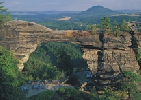 |
|
Conference venue, accommodation and arrival Excursions Conference background and aims Bohemian Switzerland National Park |
Sandstone Landscapes: Diversity, Ecology and Conservation 14 - 20 September, 2002
|
|
| Excursions | |
Two full-day excursions (pre- and mid-conference) are planned to Saxonian - Bohemian Switzerland, which is a transboundary National Park & Protected Landscape Area on both sides of the Czech-German border. It is a typical erosion sandstone landscape known for the unique Prebischtor rock bridge in Bohemian Switzerland or for table mountains in Saxonian Switzerland. The old tourist tradition of this area dates back to the period of romanticism, when Swiss and German painters "discovered" this landscape, one of them was the famous Caspar David Friedrich (1774 - 1840). A 3-days post-conference tour will be arranged to other sandstone regions in the Czech Republic: Kokorinsko Protected Landscape Area (PLA), Cesky raj PLA and Broumovsko PLA - more information about these regions and their location at Protected Landscape Areas Administration.
Pre-conference
excursion on 15 September, 2002 to the Saxonian
Switzerland (Sächsische Schweiz) National Park The German part of Elbe Sandstone Mountains, being also called Saxon Switzerland (Sächsische Schweiz), is situated to about 20 km SE of the capital of Saxony Dresden and extends as far as to the German-Czech border. Saxon Switzerland National Park consists of two component parts of the Cretaceous sandstone area, which are located right-bank of the Elbe river, covering an area of 93 km2. The excursion will take place in the rear part of the National Park. The route will lead from Bad Schandau (Elbe river valley) to mt. Großer Winterberg (556 m a. s. l., the highest mountain in Saxon Switzerland easterly of Elbe river) and to Schmilka (Elbe valley near Czech border). Some interesting and characteristic features and contents: - geology (sandstone,
basalt), geomorphology (rocks, plateaus, gorges, canyon-shaped valleys
etc.), climate ("cellar climate", inversion etc.) Mid-conference excursion on 18
September, 2002 to the Bohemian Switzerland
(Ceske Svycarsko) National Park Bohemian Switzerland National Park is a part of the Elbe Sandstones area - a Cretaceous rock region on the Czech-German border. The excursion route will lead from Mezni Louka to Hrensko into the core zone of the national park with two optional routes:
On the way back from Hrensko a stop at Belveder in the Elbe Sandstone Landscape Protected Area with a view of the deep canyon of the Elbe river is planned.
Post-conference
tour on 19-22 September, 2002 to other sandstone regions in the Czech Republic:
Kokorinsko, Cesky raj and Broumovsko Protected Landscape Areas (PLA) During the post-conference tour the participants will have a posibility of visiting three different sandstone regions of the Czech Republic. All these regions together with the Elbe Sandstones are a part of the Bohemian Cretaceous Basin: 20th September: Kokorinsko PLA - a lowland region with a high geo-, bio- and landscape diversity north of Prague. The landscape of acidic sandstones (characterised by species-poor acidophilous beech, pine-oak and pine forests on sandstones) is locally enriched by the volcanic Tertiary hills (e.g. Vlhost hill), calcium-rich sandstones and loess with rich flora and fauna of the herb-rich beech, oak-hornbeam and termophilous oak forests. It bears a combination of thermophilous and mesophilous biota. There are also wetlands of international importance (the Ramsar site "Wetlands of Libechovka and Psovka Brooks") and harmonious combination of rural settlements with landscape. 21th September: Cesky raj (Bohemian Paradise) PLA - a sandstone region in the eastern part of the country with a high diversity of geomorphological forms. The area is built by Turonian sandstones; locally, Tertiary volcanic eruptions emerge forming isolated dominating summits (e.g. the Trosky Castle). The original complex sandstone platform has been eroded into typical ”rocky cities” with labyrinths of canyon-like valleys, rocks and pinnacles. Dry pine forests prevail in the region. Cesky raj PLA is rich in architectural monuments such as castles and chateaux as well as minor monuments of folk architecture. 22thSeptember: Broumovsko PLA - a higher-altitude sandstone region in Northern-Eastern Czech Republic close to the Polish border (continuing in Poland as the Gory Stolowe National Park). The central part of the region is built by the Adrspach-Teplice Rock National Nature Reserve, which is the best example of so called ”rock cities” in the Bohemian Cretaceous basin (over 100 m high rock pillars) with extremely developed sandstone phenomenon incl. very strong climatic and vegetation inversion (with montane and subalpine elements of flora). The predominant vegetation in the Adrspach-Teplice rocks are pine and spruce forests (natural in the narrow valleys). The postconference tour will start on 19th September in the afternoon in Doubice and will end in Prague on 22th September at 17.00 at the railway station/underground or at 18:00 at the airport respectively. The cost of the post-conference excursion is 3600 CZK or 125 Euro. It will be paid at the registration desk in cash. As the registration for excursions in the first circular was only preliminary, please fill in the confirmation of participation. We cannot arrange participation at the excursions for those who register later than 19th August 2002.
|
|
